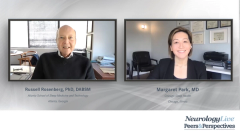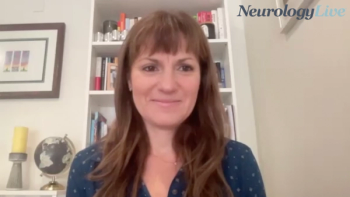
Narcolepsy Overview
Margaret Park, MD, defines typical signs and symptoms of narcolepsy and differentiates between the 2 main types of disease.
Episodes in this series

Russell Rosenberg, PhD, DABSM: Hello, and thank you for joining this NeurologyLive® case-based Peers & Perspectives® presentation titled, “Improving Diagnosis and Patient Outcomes in Narcolepsy.” Hello, I’m Dr Russell Rosenberg, and I’m chief science officer and CEO of NeuroTrials Research, as well as the founder and director of the Atlanta School of Sleep Medicine and Technology in Atlanta, Georgia. Joining me today is Dr Margaret Park, who’s a neurologist and sleep specialist in Chicago, and it’s my pleasure to speak with her. We’re going to discuss a couple of patient cases to illustrate challenges that patients as well as physicians face, and then the diagnosis of narcolepsy and treatments. We will also discuss novel and emerging treatments, and how these could help improve patient outcomes. Thanks everyone for joining us. I think you’ll find this enjoyable and useful for your practice. Let’s just get going here. Margaret, let’s start from the beginning and talk about what this disease is. I know you have a lot of experience with it. Some think it’s a super rare disease, but it’s not necessarily that, so really, what is narcolepsy?
Margaret Park, MD: Narcolepsy, first of all, it is a chronic neurological disorder. It is definitely something that occurs in your brain and it affects the sleep and wake states. A lot of people think that concerning the wake and sleep systems, we often think about it as a light switch because one turns on, the other one turns off. But we know that they’re not necessarily opposites, there is a lot of interplay between the 2 systems and they are highly coordinated. And what narcolepsy does is it imbalances that coordination, so this instability manifests as several different concerning symptoms. Sleepiness is obviously the hallmark symptom. But classically, we think of it as the tetrad: the sleepiness; the cataplexy symptoms; hallucinations as you’re waking up from sleep or surrounding sleep or going down to sleep; sleep paralysis. I think people also often mistake the idea that just because they’re sleepy during the day, that they’re also perfectly fine at night. We do know that there’s a lot of nighttime sleep disruption that occurs with this disorder.
Russell Rosenberg, PhD, DABSM: Sure, so we know there are a couple of different types of narcolepsy. But before we talk about that, let me ask you, again, some people think about this as a fairly rare disease. But what’s the prevalence? And is it seen in children or adults more often?
Margaret Park, MD: That’s the tricky question, isn’t it? We do know that a lot of times, there’s a delay in diagnosis, so there are people who manifest symptoms much earlier. And in retrospect, they do identify that, “Hey, I did have these symptoms when I was prepuberty, when I was in elementary school, when I was in high school.” A lot of times when they manifest with the symptoms, we don’t catch them. As you mentioned, it is a rare disorder. Thus, prevalence is a tricky thing because it means that people have actually come forth, they’ve identified, “Hey, I need to be evaluated,” then they have the proper evaluation and treatment. Then, we’ve gotten to the proper diagnosis. It is a rare disorder, but we don’t know really what the true prevalence is. But we do know that most studies report anywhere from let’s say, 25 to 75 per 100,000 people. It seems to be independent of race and ethnicity, maybe a slight predominance in female patients. And we always say it’s bimodal. But again, there’s this lapse between presentation and diagnosis. We see a bunch of people in their teenage years, we see a bunch of people in their late 20s, early 30s. But I think that with awareness of the disease coming to the forefront, that bimodal peak is possibly changing.
Russell Rosenberg, PhD, DABSM: I think both of us have probably seen that it may take patients years to get a proper diagnosis and see multiple specialists. That’s pretty common in practice. I think the average is maybe up to 10 years, isn’t that right?
Margaret Park, MD: That’s the latest report, and I find that’s about the correct timing. When I do see a new patient who is concerned about this, they sort of run the gamut. Whether it’s appropriate or not is not the question. It’s that there was this delay in the diagnosis and in evaluation. Hence for me, that sounds about right. Has that been your experience as well?
Russell Rosenberg, PhD, DABSM: Sure, absolutely. They wait too long, which is a terrible shame because the earlier the intervention, as with many diseases, the better the outcomes are. Well, there are 2 different types of narcolepsy I wanted to talk about here and think about some of the diagnostic issues. But talk if you will a little about what type 1 versus type 2 narcolepsy is.
Margaret Park, MD: Again, we like to categorize things in medicine because it makes it easier for us to think about the disease state. Type 1 and type 2 largely is based upon a clinical differentiation, and then that’s been supported by laboratory findings. That centers around the symptom called cataplexy, which is a very strong emotion. It could be positive or negative—fear, anger, excitement, laughter—strong emotion that triggers some sort of muscle weakness, and that muscle weakness can be diffuse. It could be maybe your vision blurs a little bit, or your facial muscles start feeling weak, or you feel a slight tingling in your knees. It may be dramatic as well; you could fall from it, you could trip, you could stumble. There are lots of different presentations of cataplexy, and it seems that cataplexy affects type 1 patients a little more than type 2 patients.
But you have to use caution with just the clinical symptom because we do know that there are a number of type 2 patients who don’t have cataplexy, and then later on, they manifest cataplexy symptoms. It’s not an absolute just because you categorize one versus the other doesn’t mean that one is more severe than the other. It seems to be based on that symptomology. Because based on those symptoms, when we look at cerebral spinal fluid [CSF], and we test the levels of orexin, which is a protein that’s in the brain that helps manage the sleep and wake state stability, we know that there are very low levels in type 1 patients, but there are intermediate levels in type 2. Thus, in the type 2 category, there seems to be more heterogeneity of clinical symptoms and presentation, possibly reflecting the varying levels of orexin in that CSF.
Transcript Edited for Clarity
Newsletter
Keep your finger on the pulse of neurology—subscribe to NeurologyLive for expert interviews, new data, and breakthrough treatment updates.



























